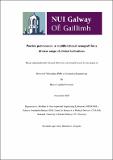| dc.description.abstract | Decellularised xenografts are an inherent component of regenerative medicine. Their preserved structure, mechanical integrity and biofunctional composition have well established them in reparative medicine for a diverse range of clinical indications. Nonetheless, the scattered results observed with tissue grafts in clinics makes patent that the ideal tissue graft does not exist yet. This motivates the investigation of alternative sources of xenografts. Herein, we investigated the potential of an under-investigated tissue graft source, porcine peritoneum / mesothelium, as biomaterial for tendon tissue engineering, as wound healing material and as stem-cell delivery vehicle.
In order to assess the potential of decellularised porcine peritoneum (XenoMEM™) as a material for tendon tissue engineering, we correlated its properties to a commercially available collagen matrix (TenoGlide®). XenoMEM™ presented lower cross-linking ratio (p < 0.05), higher mechanical properties (p < 0.01), lower coefficient of friction (p < 0.01) and higher (p < 0.05) cytocompatibility with human tenocytes than TenoGlide®. In addition, XenoMEM™ exhibited lower (p < 0.05) immune response than TenoGlide® with macrophages. Collectively, these data support the use of XenoMEM™ in tendon tissue engineering.
To assess porcine peritoneum as wound healing biomaterial, we compared the biochemical and biological properties of the only two commercially available porcine mesothelium grafts (Meso Biomatrix® and XenoMEM™ / Puracol® Ultra ECM) to traditionally used wound healing grafts (Endoform™, ovine forestomach and MatriStem®, porcine urinary bladder) and biomaterials (Promogran™, collagen / oxidised regenerated cellulose). The Endoform™ and the Puracol® Ultra ECM showed the highest (p < 0.05) soluble collagen and elastin content. The MatriStem® had the highest (p < 0.05) FGFb content, whilst the Meso Biomatrix® had the highest (p < 0.05) TGF-β1 and VEGF content. All materials showed tissue-specific structure and composition. The Endoform™ and the Meso Biomatrix® had some nuclei residual matter. All tissue grafts showed similar (p > 0.05) response to enzymatic degradation, whereas the Promogran™ was not completely degraded by MMP-8 and was completely degraded by elastase. The Promogran™ showed the highest (p < 0.05) permeability to bacterial infiltration. The Promogran™ showed by far the lowest dermal fibroblast and THP-1 attachment and growth. All tested materials showed significantly lower (p < 0.05) TNFα expression than the LPS group. The MatriStem® and the Puracol® Ultra ECM promoted the highest (p < 0.05) number of micro-vessel formation, whilst the
xxii
Promogran™ the lowest (p < 0.05). Jointly, these data confer that porcine mesothelium has the potential to be used as a wound healing material.
Finally, we assessed the potential of porcine peritoneum (XenoMEM™) and other two commercially available extracellular matrix-based biomaterials [a collagen / glycosaminoglycan scaffold (Integra™ Matrix Wound Dressing) a porcine urinary bladder (MatriStem™)] as human adipose derived stem cell delivery vehicles. Both tissue grafts induced significantly (p < 0.01) higher human adipose derived stem cell proliferation in vitro over the collagen scaffold, especially when the cells were seeded on the basement membrane side. Human adipose derived stem cell phenotype and trilineage differentiation potential was preserved in all biomaterials. In a splinted wound healing nude mouse model, in comparison to sham, biomaterials alone and cells alone groups, all biomaterials seeded with human adipose derived stem cells showed a moderate improvement of wound closure; a significantly (p < 0.05) lower wound gap and scar index; and a significantly (p < 0.05) higher proportion of mature collagen deposition and angiogenesis (the highest, p < 0.01, was observed for the cell loaded at the basement membrane XenoMEM™ group). All cell-loaded biomaterial groups retained more cells at the implantation side than the direct injection group, even though they were loaded with half of the cells. Therefore, these results further advocate the use of extracellular matrix-based biomaterials (in particular porcine peritoneum) as human adipose derived stem cell delivery vehicles.
Altogether, this study supports further preclinical and clinical investigation on porcine peritoneum as biomaterial for the fields assessed, whilst the positive results observed encourage further analysis in other scenarios of regenerative medicine. | en_IE |


